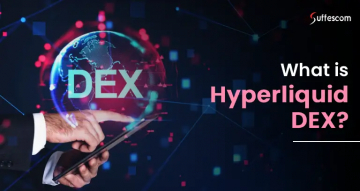How to Create a Custom DeFi Token? - A Thorough Guide

In April 2025, people locked up over $94 billion in DeFi platforms, showing how fast these new finance services are growing. Considering this rising demand, various businesses now want to create DeFi tokens. A clear roadmap is essential to bring out the best results.
This guide explains what a DeFi token is and covers different categories of DeFi tokens and their core features. You will learn the process to create your own DeFi token, cost factors, and best optimization practices to develop robust and scalable tokens.
What is a DeFi Token?
When businesses decide to create DeFi tokens, they unlock a blockchain-powered digital asset that enables governance, rewards, and peer-to-peer value transfer. A DeFi token is a smart-contract-based unit that powers decentralized finance services and aligns stakeholder incentives without intermediaries.
Think of DeFi tokens as currencies that are applicable only in decentralized financial ecosystems. Since you cannot process blockchain-based transactions using fiat currency, DeFi tokens act as that currency, enabling you to process decentralized financial services.
Different Types of DeFi Tokens
Understanding what a DeFi token is lays the foundation to create your own DeFi token. Still, before jumping into the process, it is essential to understand the different DeFi token types.

1. Utility Tokens
Utility tokens grant access to a platform's services, benefit platform engagement, and improve users' trust in brands. Use cases of utility tokens include fee payment, unlocking features, and staking for discounts. Binance Coin (BNB) and Uniswap (UNI) are popular utility tokens.
2. Governance Tokens
Governance tokens help establish decentralized control and align stakeholder incentives by granting voting rights in the blockchain's decisions. These tokens are ideal for proposing and voting on fee changes, grants, and updates. Popular governance tokens are Maker (MKR) and Compound (COMP).
3. Stablecoins
Stablecoins' value is pegged to real-world assets such as fiat currency (USD), gold, or real estate. They are perfect for acting as a medium of exchange and collateral in lending/borrowing. Such DeFi tokens ensure great price stability and decrease volatility risk. Some renowned stablecoins are Tether (USDT) and USD Coin (USDC).
Bonus Read: How to Create a Stablecoin
4. Security Tokens
These are the digitized shares or bonds on blockchain used in equity crowdfunding, revenue sharing, and asset tokenization. Security tokens promise regulatory compliance and fractional ownership. tZERO (TZERO) and Securitize (DS Protocol) are prominent examples of security tokens.
5. Reward & Yield Tokens
Reward and yield tokens result from the incentives earned by providing liquidity in DeFi yield farming and liquidity mining programs. These DeFi tokens, such as Aave (AAVE) and Curve (CRV), provide extra earnings and improve protocol engagement.
Also Read: DeFi Protocol Development Like Aave
6. Asset-Backed Tokens
Asset-backed tokens represent real-world assets and are perfect for trading tokenized stocks and commodities. Tokens like Synthetix (SNX) and PAX Gold (PAXG) provide access to non-crypto markets and diversify portfolios.
How to Create a DeFi Token That Works Across Use Cases?
From governance and fundraising to loyalty rewards and asset tokenization, our DeFi token development solutions fit every business vision. Connect now to create DeFi tokens and discover what these can do for your project.
Understanding the Core Features of the DeFi Tokens
When teams design tokens, they must know what makes them effective. This guide shows the essential characteristics to consider when you create DeFi tokens. Let’s explore!
1. Governance & Voting Rights
A strong governance model ensures token holders can propose and vote on protocol changes, building trust and aligning incentives.
2. Supply Control & Minting
Automatic caps or adjustable supply mechanisms prevent uncontrollable inflation. A well‑defined minting and burning rules keep token economics stable.
3. Incentive & Reward Structures
Clear reward logic encourages desired behaviors like DeFi staking or liquidity provision. Proper incentive curves attract long‑term participants.
4. Staking & Yield Mechanisms
Staking features lock tokens to secure the network or fund pools. Participants earn yields, reinforcing engagement and optimizing network health.
5. Interoperability & Composability
Seamless integration with other protocols boosts utility. Standards like ERC‑20 enable tokens to plug into crypto wallets, exchanges, and DeFi applications.
6. Security & Auditability
Built-in security measures, such as multi‑sig controls or timelocks, reduce risks. Regular code audits and on‑chain transparency further protect users.
7. Upgradeability & Governance Models
Modular designs support future upgrades. When teams explore how to create a DeFi token, they should plan for governance and upgrade paths.
8. Distribution & Fair Launch
Transparent token distribution builds community trust via airdrops, sales, or liquidity mining. Vesting schedules and lockups prevent large dumps.
9. Oracle & Data Integration
Access to reliable off‑chain data enables price feeds, lending rates, and real‑world asset tokenization. Oracles are critical for accurate protocol operations.
10. Fee Structure & Economic Design
Defining fee flows determines protocol sustainability. A portion of collected fees can fund development or governance treasuries.
11. Transparency & On‑Chain Analytics
Detailed on‑chain records allow stakeholders to verify token flows and voting outcomes. Additionally, using dashboards and analytics tools enhances visibility.
12. Cross‑Chain Bridges & Liquidity
Bridges expand tokens' reach to other blockchains, increasing their utility and the depth of their markets. Proper bridge security is vital to prevent exploits.
A reliable DeFi development company always focuses on incorporating these features while creating DeFi tokens. Focusing on these core features will lay a strong foundation for token success if you aim to create your own DeFi token.
Bonus Read: How To Create A Decentralized Finance App?
How to Create a DeFi Token?
Creating DeFi tokens is a powerful way to enhance your project using blockchain technology. Whether you're a founder, fundraiser, or community leader, understanding how to create a DeFi token can drive innovation and engagement.
This section outlines the essential steps to guide you through the process.

Step 1. Define the Purpose and Use Case
Start by deciding why you need a token and how it will work in your project. This initiative will also help you choose the right DeFi token type, ranging from utility, governance, to security tokens.
Defining the token's purpose and use case is crucial, as they shape everything else. Market research and community input are ideal for matching the token goals with audience needs.
Step 2. Choose the Blockchain Platform
Selecting the blockchain platform, among Ethereum or Binance Smart Chain, that would host your DeFi token. Each blockchain platform offers different benefits, such as higher transaction speed or lower transaction cost.
This step in the search for how to create your own DeFi token is crucial as it impacts usability and reach, resulting in higher efficiency and user experience. When choosing the right blockchain platform, always focus on the three primary considerations: costs, speed, and support.
Step 3. Designing Token Economics
Since tokens are the most fundamental part of the DeFi protocol, it is crucial to plan them to save costs on rework. Since tokens serve various purposes, you must decide how you want your token to function within the DeFi ecosystem.
- Define the complete token supply.
- Determine the distribution mechanisms.
- Deciding the incentives for holding & using the tokens.
Consider applying dynamic fees in DeFi to optimize transaction costs based on network activity to improve user engagement.
Step 4. Developing a User Interface
Undoubtedly, an appealing and easy-to-use application interface attracts and retains users. Let users easily navigate the platform with an intuitive dashboard that facilitates important functions such as lending, borrowing, or staking.
Ensure to use clear language and simple instructions to assist the users undergoing complex processes. The purpose is to make it easier for the users to interact with the protocol and improve user engagement.
Step 5. Smart Contract Development
A crypto token cannot run without DeFi smart contract development. These automate the processes that let users interact with your platform, manage transactions, and govern blockchain.
Writing precise and efficient code to reduce gas fees and improve user experience while developing smart contracts is essential. Mere development is not enough; testing is equally important. Testing helps identify and fix bugs before deployment.
Step 6. Security Audits
A security compromise leads to heavy financial losses, and nobody wants that. So, before launching your protocol, audit your smart contract with professional security and testing experts. Such experts identify potential vulnerabilities and suggest improvements.
Audits also ensure higher customer trust and keep the funds secure. It is healthy to invest in testing to avoid spending costs later in the process.
Step 7. Market Launch
Any potential error could occur anytime during the launch and deployment. Pay utmost attention to each factor that could result in a delay. If you want the public to know about your recently launched DeFi token, use social media and other marketing channels to announce the launch; create a buzz to attract a wider user base!
What’s the Cost to Develop a DeFi Token?
There are certain factors that affect the cost to create DeFi tokens, it is important to analyze these factors to get a scalable and market-ready DeFi token. Let’s dig deeper!
- Token design and economics impact the cost with economic modeling tools and consultant fees.
- Developing and testing smart contracts requires skilled blockchain developers and multiple test runs. Each iteration costs in developer hours and network fees.
- Security testing and audits factor includes audit firm fees, internal code reviews, automated testing tools, and bug‑bounty programs.
- Certain factors, including API access, hosting fees, and listing applications, also impact the cost range during the launch.
- Post‑launch, you must allocate funds for monitoring, smart contract upgrades, and customer support.
Create DeFi Tokens that Fuel Growth
Design purpose-built DeFi tokens that drive governance, incentives, and user engagement. We help you create DeFi tokens that truly deliver. We are just a click away; create your own DeFi token now!
The Best Cost Optimization Practices for DeFi Token Development
As of May 2025, total value locked in DeFi reached $142.5 billion. It is a clear hint that to emerge superior in a cut-throat market, the new entrants must focus on implementing cost optimization practices in DeFi token development.
1. Leverage Standard Templates
Instead of building from scratch, use audited, open‑source code templates. This cuts initial development time and avoids hidden bugs. Templates tailored for different types of DeFi tokens help you move faster with fewer errors.
2. Modular Development Approach
Break your project into small, reusable modules—such as token logic, access controls, and reward distribution. Teams can work in parallel, reducing overall labour hours. Modular code is easier to test and upgrade, keeping long‑term maintenance costs low.
3. Early Automated Testing
Integrate automated checks for common issues at the initial stages. Early automation catches mistakes before they become expensive. Automated tests also speed up ongoing updates, ensuring your token remains secure as markets evolve.
4. Batch Transactions & Gas Optimization
Gas fees can increase costs on popular networks. Wherever possible, group actions like token distribution or parameter updates into single transactions. Slash network fees and accelerate deployment with code alterations, such as minimizing storage operations.
5. Selective Third‑Party Audits
A full audit is heavy on the pocket. So, tackle this, focus external reviews on critical modules, especially those handling token minting, burning, or funds. Pair this with internal peer reviews to balance cost and security.
6. Cloud‑Native Infrastructure
Host monitoring, analytics, and front‑end services on scalable cloud platforms. Choose pay‑as‑you‑grow pricing to avoid over‑provisioning. Use automated scaling and only pay for your resources, keeping operations lean.
Note: To ensure that you apply these cost optimization techniques when creating a DeFi token, you must have the assistance of a professional DeFi wallet development company.
Bonus Read: How to Develop a White Label DeFi Wallet?
Let’s Wrap It Up!
Here’s a quick recap: Decentralized financial services are growing, and it is high time for every commercial entity to create DeFi tokens. DeFi tokens are a currency used to execute decentralized financial operations.
There are mostly five types of DeFi tokens, including utility tokens, governance tokens, stablecoins, security tokens, reward & yield tokens, and asset-backed tokens.
These types include several essential features that maintain and improve their functionality. Those features are governance and voting rights, supply control and minting, incentive and reward structures, staking and yield mechanisms, security and auditability, and various others.
Developing a DeFi token follows a standardized process that starts with defining the purpose. This is followed by choosing a blockchain platform, designing token economics, developing a user interface, creating smart contracts, performing security audits, and finally launching it.
The development process incurs a cost, but it is important to implement cost optimization techniques as well. Optimization methods include leveraging standard templates, applying a modular development approach, implementing early automated testing, batch transactions and gas optimization, third‑party audits, and using cloud‑native infrastructure.
FAQs
1. How do I create my own token?
A definite process to create DeFi tokens starts with defining the token's purpose. Further steps include choosing a blockchain platform, designing token economics, developing a user interface, creating smart contracts, performing security audits, and launching it.
2. How much does it cost to create your own token?
It costs between $10,000 and $30,000 to create your own DeFi token and launch it in the market. This cost range is affected by factors such as token design and economics, innovative contract development and testing, security testing & audits, and various others.
3. Is it legal to create your own crypto token?
Yes, it is legal to create your own crypto token. However, some countries and regions have imposed a partial or complete ban on cryptocurrency.
4. What are the features of a DeFi token?
A DeFi token's features include governance and voting rights, supply control and minting, incentive and reward structures, staking and yield mechanisms, security and audits, etc.







